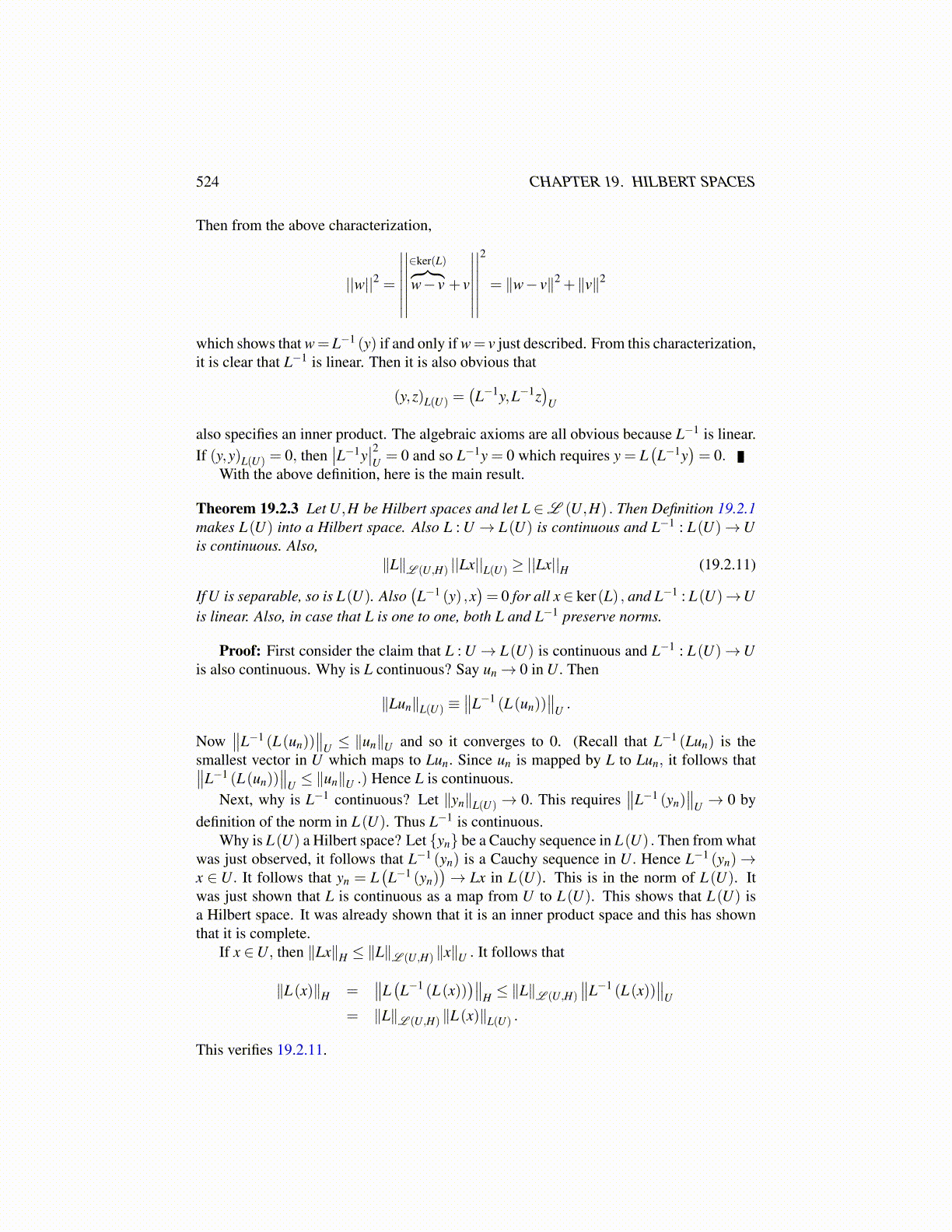
524 CHAPTER 19. HILBERT SPACES
Then from the above characterization,
||w||2 =
∣∣∣∣∣∣∣∣∣∣∣∣∣∣∈ker(L)︷ ︸︸ ︷w− v + v
∣∣∣∣∣∣∣∣∣∣∣∣∣∣2
= ∥w− v∥2 +∥v∥2
which shows that w= L−1 (y) if and only if w= v just described. From this characterization,it is clear that L−1 is linear. Then it is also obvious that
(y,z)L(U) =(L−1y,L−1z
)U
also specifies an inner product. The algebraic axioms are all obvious because L−1 is linear.If (y,y)L(U) = 0, then
∣∣L−1y∣∣2U = 0 and so L−1y = 0 which requires y = L
(L−1y
)= 0.
With the above definition, here is the main result.
Theorem 19.2.3 Let U,H be Hilbert spaces and let L ∈L (U,H) . Then Definition 19.2.1makes L(U) into a Hilbert space. Also L : U → L(U) is continuous and L−1 : L(U)→Uis continuous. Also,
∥L∥L (U,H) ||Lx||L(U) ≥ ||Lx||H (19.2.11)
If U is separable, so is L(U). Also(L−1 (y) ,x
)= 0 for all x∈ ker(L) , and L−1 : L(U)→U
is linear. Also, in case that L is one to one, both L and L−1 preserve norms.
Proof: First consider the claim that L : U → L(U) is continuous and L−1 : L(U)→Uis also continuous. Why is L continuous? Say un→ 0 in U. Then
∥Lun∥L(U) ≡∥∥L−1 (L(un))
∥∥U .
Now∥∥L−1 (L(un))
∥∥U ≤ ∥un∥U and so it converges to 0. (Recall that L−1 (Lun) is the
smallest vector in U which maps to Lun. Since un is mapped by L to Lun, it follows that∥∥L−1 (L(un))∥∥
U ≤ ∥un∥U .) Hence L is continuous.Next, why is L−1 continuous? Let ∥yn∥L(U) → 0. This requires
∥∥L−1 (yn)∥∥
U → 0 bydefinition of the norm in L(U). Thus L−1 is continuous.
Why is L(U) a Hilbert space? Let {yn} be a Cauchy sequence in L(U) . Then from whatwas just observed, it follows that L−1 (yn) is a Cauchy sequence in U. Hence L−1 (yn)→x ∈U. It follows that yn = L
(L−1 (yn)
)→ Lx in L(U). This is in the norm of L(U). It
was just shown that L is continuous as a map from U to L(U). This shows that L(U) isa Hilbert space. It was already shown that it is an inner product space and this has shownthat it is complete.
If x ∈U, then ∥Lx∥H ≤ ∥L∥L (U,H) ∥x∥U . It follows that
∥L(x)∥H =∥∥L(L−1 (L(x))
)∥∥H ≤ ∥L∥L (U,H)
∥∥L−1 (L(x))∥∥
U
= ∥L∥L (U,H) ∥L(x)∥L(U) .
This verifies 19.2.11.